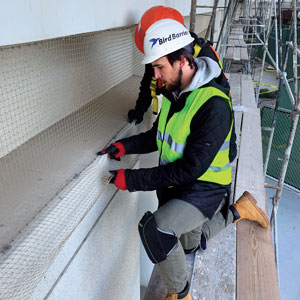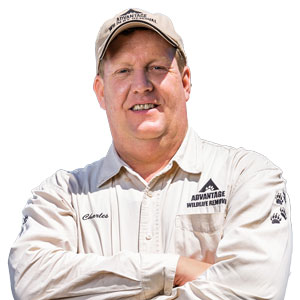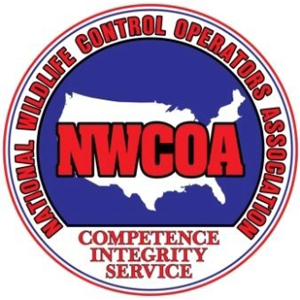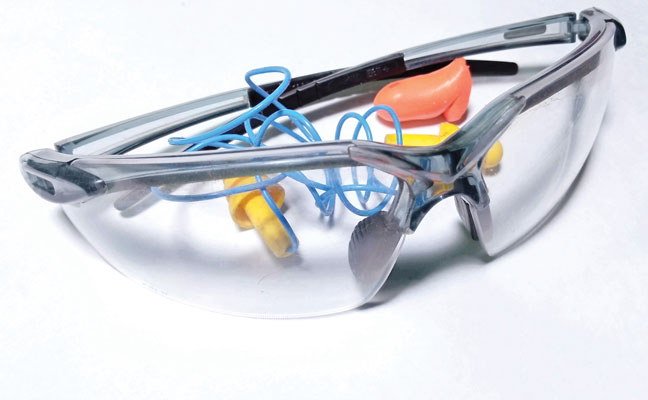
Be prepared: PPE such as hard hats, reflective vests, gloves, knee pads, and steel-toed boots, are all in a day’s work for bird control specialists. Photo: Michael Gallion, Bird Barrier
Scrolling online these days, most news stories that are linked to “bird control” are not what pest management professionals (PMPs) have in mind when they hear the term. Such a news search yields mostly links to the latest reports on an outbreak of highly pathogenic avian influenza (HPAI) A (H5N1) in yet another metropolitan market, where local backyard coop enthusiasts and poultry farms alike must cull their flocks to keep infected birds spreading it to others. Since it was first detected in March 2020, this worldwide flu strain has made the jump from birds to mammals — including a black bear, a mountain lion and yes, even humans. (Source: CDC.gov/flu/avianflu/timeline/avian-timeline-2020s.htm.)
For PMPs, though, it should be just another day on the job to take all proper safety precautions, especially when treating food processing facilities or residences that keep a few wild ducks in the yard. The pest control industry is well versed on wearing the proper personal protective equipment (PPE) and avoiding cross-contamination of tools, etc., to protect technicians from inadvertently spreading the virus. (See sidebar, “Be holistic in your PPE choices,” at the end of the article.)
For bird control accounts, the requisite PPE is similar to a rodent cleanout account, notes Rolie Calzadilla, CWCP, CGC, owner of Pest Wildlife Pro, Miami Lakes, Fla. “Just like with rodent waste, the biggest risk is with aerosolized, dried bird droppings, so a good-fitting, full-face respirator is a must,” adds Calzadilla, who has more than 25 years of experience in bird management. “I prefer full-face respirators because I also want to protect my eyes. And ear protection not only is good for noise, but also protects your ears from bird waste getting in, especially if you’re using a pressure washer.”

Charles Holt
Charles Holt, CWCO, CNI, MN, agrees. The operations director of the National Wildlife Control Operators Association (NWCOA) and owner of New Richmond, Ohio-based Advantage Wildlife Removal, laments that in some cases, common sense isn’t common — so be sure to train and retrain as needed. “I’ve seen operators take off respirators and then proceed to remove their coveralls and gloves, breathing in the stuff on the outside of their PPE,” he says. “Take the respirator off last.”
While at press time, this newest crop of avian flu does not seem to pose a danger to humans, it is something to keep an eye on. That’s according to Dr. Jay Tischendorf, a corporate veterinarian and ecological consultant based in Lisbon, Maine.
“I’m extra concerned right now, and that says a lot, because I’m already very cautious and concerned when it comes to wildlife, pests and zoonotic diseases,” says Dr. Tischendorf, who is also NWCOA’s zoonotic staff specialist. “Of all the dangers out there, influenza keeps experts up most at night. What we’re seeing, with avian flu jumping from birds to mammals, is one example why experts take influenza so seriously.”
For now, he advises, “use extra care and caution when handling birds and animals. I suggest full PPE and maintaining tight vigilance and discipline with hygiene and equipment cleaning and disinfection.”
Jeff “The Pest Coach” McGovern advises also to not discount customer concerns over the lingering risk of COVID-19. If a customer requests you put on a mask to enter his/her residence, be respectful and just do it: “If nothing else, it’s offering them peace of mind.”
Equipment must-haves
For PMPs looking to get into bird control, or to improve their existing services, there is basic equipment in which to invest. Netting, mist nets, electrified tracks and spikes are must-haves, but so is keeping half-inch hardware cloth on hand for exclusion. New technologies, such as optical discs, are becoming increasingly popular. Calzadilla also recommends box traps to remove house sparrows (Passer domesticus) from inside commercial buildings, an increasingly common occurrence. “Being able to respond quickly to an urgent request for an interior removal of a house sparrow in a grocery store or food warehouse can be worthwhile,” he points out.

Jeff McGovern
Vacuums with high-efficiency particulate air (HEPA) filters also are essential, notes McGovern, as are ladders — with the caveat that the ladder fits the tech, who also has had training in ladder safety. “We shouldn’t have to point this out, but a tech with a pro wrestler build shouldn’t be issued a ladder rated for 210 pounds,” McGovern says. “Give techs ladders that will support their sizes. Also, provide documented training, at least once year. If you’re in a cold climate, for example, maybe offer it again in the winter: How are you bracing your ladder in the snow and ice?”
In addition to the above, Holt points to lasers and other avian deterrents as being helpful bird control tools. But most of all, he advises, ensure you know what bird control permits are required in your service areas. If you’re treating for anything besides a pigeon (Columba livia domestica), starling (Sturnus vulgaris) or sparrow, chances are good that you need a federal permit (not including game birds during specific seasons).
Another commonly overlooked aspect is when to use screening. “Dryer vents never should be screened or have a cover installed that can trap lint because of the fire risk,” Holt adds, noting there are plenty of vent products that do not pose such a risk. Where there are places where screening is the right option, Holt says, make sure you have all the tools you need to cut and bend wires and other materials for installation. Also, measure once, cut twice: “Laser measurement devices are a huge time-saver.”
Train for success
McGovern points out that bird control service is no place to cut corners. “This starts with the hire,” he continues. “If a person cannot crouch and crawl, climb ladders and deal with heights, he or she is not right for the job.”
On the other hand, he says, most failures in bird control work can stem from not getting help when needed. Most product manufacturers and distributors are happy to troubleshoot problems as opposed to going it alone and possibly not getting it resolved. For bird roost cleanouts, consider the return on investment, McGovern says.
“Maybe you have a three-person crew, but outsourcing to a 10-person restoration crew to clean out all the droppings quickly and safely might be a better use of time and money,” he explains. “Foster relationships with companies that specialize in this, and put your team to work on what they do best: controlling pests.”
Finally, McGovern recommends PMPs invest the time needed to get to the root of bird control problems. “The impulse for some companies is to race into situations, just to ‘do something harder than the last guy.’ Then they get fired and the next guy comes in,” he says. “Instead, we need to stand back, observe, and say ‘I can do this.’ And do it.”

NWCOA and bird control
The National Wildlife Control Operators Association (NWCOA) offers Level I and Level II bird management courses, after which attendees become NWCOA Certified Bird Management Professionals. Level I covers species, biology, solutions and more; Level II offers hands-on instruction on repairs and more. In addition, the NWCOA Zoonotic Awareness Course is designed to provide information to protect both customers and technicians. Learn more about all three courses online at NWCOA.com.
Be holistic in your PPE choices

Photo: Wawan Riswandy/iStock / Getty Images Plus/Getty Images
“You have to think of all five senses when you choose your personal protective equipment (PPE), and this goes for not only birds, but every account,” advises Jeff “The Pest Coach” McGovern, a longtime industry consultant based in Palatka, Fla. “If one sense goes down, the others won’t work.” McGovern’s recommendations for the items pest management professionals should have in a PPE kit on every truck, for each of the senses, are:
Sight: Protect your eyes. Even something as simple as grit in the air can damage your vision. Have both safety glasses and goggles as options for each situation. For bird control inspections in particular, having safety-rated sunglasses is a must. When you open a roof hatch of a building and climb outside, there’s a good chance you’re going to be blinded by sunlight — and only rarely are there railings. There are, however, plenty of pipes and lines for you to trip over and fall. Also, consider your head protection: Does the brim on your hard hat interfere with your vision line?
Sound: Muffs and earplugs should be in every PPE kit to protect your hearing, especially at industrial accounts.
Smell and Taste: Prepare for the environment. Is it going to be dusty and dirty, such as in a hard-to-access attic? Don’t breathe it in; put on a full- or half-face respirator, with proper cartridges. Also find out as much as you can about the history of the account you’re going into, such as what insecticide might already be laid down in the space and when.
Touch: In addition to gloves — chemical-resistant for general work, and a thicker pair for ladder work and other, more rugged tasks — consider wearing coveralls you can take off and throw into a garbage bag for disposal or laundering once you are finished at the account. Also, consider your footwear: Sneakers aren’t going to protect your feet from a nail puncture. You also need to wear shoes with a grip: There’s nothing like “making new attic access” at an account that is technician-shaped! —H.G.
Leave A Comment